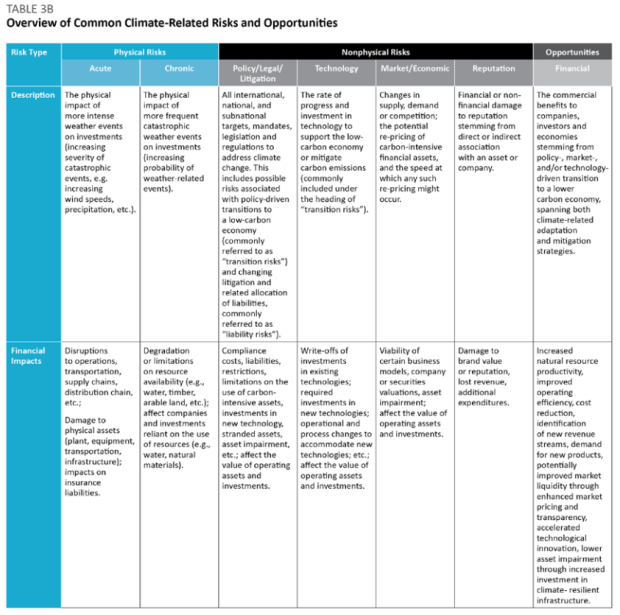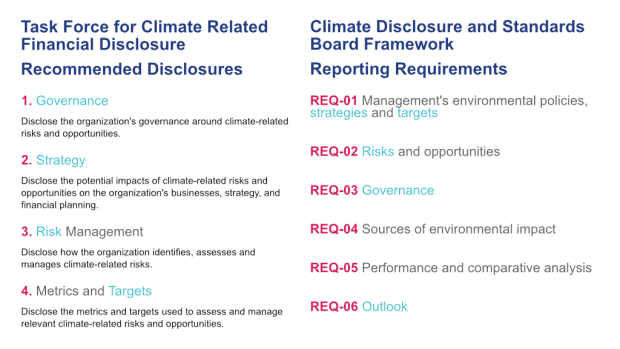The TCFD has stipulated that it is focused on financial risks related to climate change, but what does this mean? CDSB Founding Director Lois Guthrie considers this in the second part of our TCFD series.

Aren’t there already rules that could apply?
The TCFD’s Phase 1 report made it clear that the Task Force is “focused on financial risks…related to climate change rather than on broader sustainability issues such as poverty, health and migration. The report claims that existing mandatory disclosure requirements tend to relate to climate-related information generally and are not explicitly focused on climate-related financial information. The example that follows suggests that the Task Force regards GHG emissions as general climate-related information rather than climate-related financial information.
This leads me to ask, what is a financial risk related to climate and what climate related financial information should be disclosed?
Generally, I interpret financial risk (in the context of corporate performance) to mean a fluctuation in cash flows, financial results or company value that might affect the company’s financial condition or impose additional risk on shareholders. Governor Carney, referring to transition risks has described them as “the financial risks that could result from the process of transition towards a lower-carbon economy. Changes in policy, technology and physical risks could prompt a reassessment of the value of a range of assets as costs and opportunities become apparent.”
The Phase 1 report does not give an explicit definition for the purposes of climate disclosure but says that financial risks include, but are not limited to, risks to both physical and financial assets and future cash flows resulting from climate-related impacts. Financial impacts include:
- write-offs of investments in existing technologies in response to the risk of progress;
- investment in new technology to support the low carbon economy or mitigate carbon emissions; and
- asset impairment affecting the value of operating assets and investments in response to the risk of the potential re-pricing of carbon-intensive financial assets.

Source: Task Force for Climate related Financial Disclosures, Phase 1 Report
What does this mean in practice for corporate reporting? The Phase 1 report says that:
“the company should provide disclosures to the extent the underlying aspects (by which I assume they mean climate related risks) can have a significant impact on the business model, strategy risks or future cash flows”.
There might be some clues in the limited details the TCFD has released about their forthcoming recommendations since my last blog in July. It looks like four categories of climate information will be required from businesses, covering climate:
- Governance;
- Strategy;
- Risk management; and
- Targets and metrics.
Most of the proposed recommendations are similar to the reporting requirements in the CDSB Framework. However, there are two information points described as being “under consideration”, which distinguish the Task Force’s approach.

First, under “strategy”, companies might be required to disclose the impact of a 2-degree scenario on their business model, strategy and financial planning.
Secondly, under targets and metrics, companies might be required to disclose, where appropriate “the outputs, processes and underlying assumptions for assessing the impact of climate-related risks and opportunities under scenarios, including a scenario in line with current internal commitments.” As Governor Carney said in his recent speech, much depends on what form these scenarios take (eg; whether “pinned” to NDCs or the two-degree goal) and whether the transition to the low-carbon economy is smooth or sudden.
Scenario analysis will be a challenge then, but companies face financial risks from various sources all the time – potentially even from Brexit! There must be financial reporting standards that already apply where those risks potentially threaten the company’s financial condition.
I am guessing that many professionals anticipating how to respond to the TCFD’s recommendations are not accountants – and I am not either. However, my first instinct when researching a question about financial risk is to consult the body of International Financial Reporting Standards (IFRS) and associated materials issued by the International Accounting Standards Board (IASB) on the assumption that IFRSs must already explain how companies should account for, or report on financial risk (whether related to climate change or other risks).
An IASB staff paper on materiality provides an example relating to the impact of climate change risks on the financial report. It refers to the 2-degree commitment emerging from Paris and the claim that a consequence of achieving such a goal could be that a large proportion of oil, gas and coal reserves will be “stranded.” The staff paper states “information about the impact or potential future impact on an entity’s financial performance and financial position of risks, including climate change risks, may be material information that requires inclusion in an entity’s financial report.
Some IFRS standards, specifically IAS 36 Impairment of Assets and IAS 37 Provisions, Contingent Liabilities and Contingent Assets, set out IFRS requirements that could be relevant to some of the risks posed by climate change.
Other IFRS standards, including IAS 1 Presentation of Financial Statements contain general requirements to disclose information in an IFRS financial report in circumstances where there are no specific requirements.
IAS 1, 36 and 37 are much too complex to explain here (even if I could!) Their application depends on many factors, there are exclusions from scope and processes to be applied in order to determine whether a risk is within the remit of the standards.
The point I want to convey is that we now have confirmation in an IASB staff paper that these standards are capable of applying to climate change risks and might result in financial statement reporting requirements if material. These standards might already require companies to take action (for example to retire/decommission an asset, make a provision in the accounts) or report information (e.g.: an impairment loss) even without the TCFD recommendations. In a recent article in the FT reporting regulatory probing into whether Exxon has appropriately revalued its assets to reflect the current and future impact of climate change seems to confirm this.
Professionals developing a strategy for responding to the TCFD’s recommendations will therefore need to involve finance and accounting colleagues at an early stage to determine whether any existing financial reporting standards impose reporting requirements related to climate risk.
For the avoidance of doubt, where financial reporting standards already potentially apply to the type of financial risk related to climate change that the Task Force anticipates, it would be helpful if they or maybe the IASB could clarify this further.
If financial reporting standards don’t apply, or only cover a sub-section of climate-related financial risks, companies will have to consider what other resources they should use to prepare climate information. We hope to consider this in subsequent blogs when we will look at what type of information companies should supply in order to encourage financial market participants to use it.